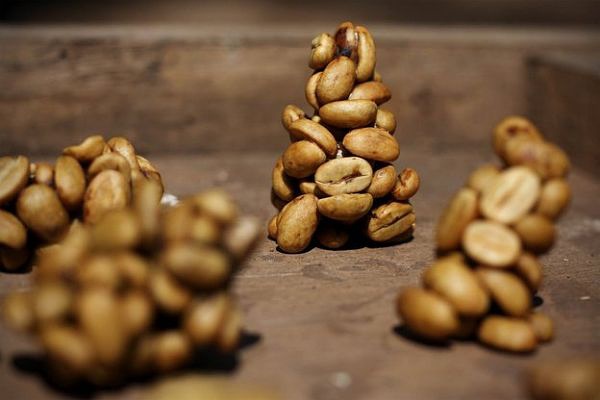Guatemala Antigua coffee Guatemala Antigua coffee beans Guatemala coffee bean producing areas
Eight major coffee producing areas in Guatemala. Ekatra Valley (Acatenango Valley?)
The Acatenango Valley Valley, which is 2000 meters (6500 feet) above sea level, is shaded and ecologically unique, and the nearby Fuego volcano continues to erupt, making its coarse, sandy soil rich in a variety of minerals. Temperate sea breezes from the Pacific and a seasonal climate allow coffee in this region to be dried by sunlight and processed according to traditional family methods that have been accumulated over the years.
The characteristics of coffee cups in Ekatlu Valley (Acatenango Valley? Cup profile):
Acatenango Valley? Cup profile [Note] Frag/Aroma: aroma / aroma Flavor: flavor Acidity: acidity Balance: balance Body: alcohol thickness Aftertaste: aftertaste (aftertaste) Overall: overall (impression) 2. Antigua coffee (Antigua Coffee?):
Rich volcanic soil, low humidity, plenty of sunshine and cool nights are the climatic characteristics of Antigua coffee producing areas. The valley is surrounded by three volcanoes: Agua, Fuego and Acatenango. Tierra del Fuego volcano is one of the three most active volcanoes in Guatemala, and the ash from frequent eruptions makes the soil of Antigua rich in minerals. The volcanic pumice in the soil can maintain humidity and help overcome the lack of rainfall in Antigua. In addition, the tree shade in this area is particularly dense, which can withstand occasional frosts and protect coffee plants from frosts.
Characteristics of Antigua coffee cups (Antigua Coffee? Cup profile) Antigua Coffee? Cup profile is rich in wet fragrance, good balance, high sweetness and elegant taste.
3. Traditional Traditional Atitl á n is one of the five major volcanic coffee producing areas in Guatemala, and its soil organic matter is the most abundant among the five volcanic coffee producing areas. 90% of the traditional Atilan coffee is grown on the violent volcanic slopes of Lake Attila, where the daily breeze stirs the lake, which is an important factor affecting the microclimate of the region. The area has accumulated excellent planting and processing techniques for a long time.
Traditional Attilan coffee cup test features (Traditional Atitl á n? Cup profile):
Traditional Atitl á n? Cup profile has a refreshing aroma, bright acidity and full thickness.
4. Rainforest Coban (rainforest) is cloudy, rainy and cool all the year round. The vast majority of Koban coffee in the rainforest is grown in the obviously undulating and foggy mountains of the region and is deeply influenced by limestone and clay in the Atlantic basin. Koban has two seasons: the rainy season and the rainy season.
Rainforest Coban Cup characteristics (Rainforest Coban á n? Cup profilRainforest Cob á n? Cup profile5. The Waiqiang Plateau (Fraijanes Plateau?)
The area is of volcanic soil, with high altitude, sufficient rainfall and great humidity variation. Ash from Pacaya, Guatemala's most active volcano, provides important minerals for the soil in the region. There is plenty of sunshine in the dry season, and although the clouds and dew are heavy in the morning, they dissipate quickly. As a result, 100% of the coffee in the area is processed in the full sun.
Characteristics of Waiqiangs plateau coffee cups (Fraijanes Plateau? Cup profile) Fraijanes Plateau? The acidity of cup profile is bright and consistent, the aroma is full, and the thickness of alcohol is delicate.
6. Micro Nanguo Highland (Highland Huehue?):
Of the three major non-volcanic coffee producing areas in Guatemala, the Mini Tenango Highlands has the driest climate and the highest elevation. The dry and hot wind from Mexico's Tehuantepec plateau protects the region's coffee from frost and can be grown to 2000 meters (6500 feet). Because of its remote location, all coffee farmers have to process their own coffee, but fortunately there are so many streams in the area that small processing plants can be set up almost anywhere.
The characteristics of micro Nanguo Highland Coffee Cup (Highland Huehue? Cup profile) Highland Huehue? Cup profile has high acidity, pleasant acidity, high alcohol thickness and wine aftertaste.
7. New Oriental (New Oriente?)
Coffee in this area has been grown entirely by small farmers since the 1950s, and now every farmer in the mountains is a coffee production unit. This area, once the most remote and poorest part of Guatemala, is now alive and well. Rainy, cloudy, New Oriental ancient times is a volcanic area, soil volcanic metamorphic rock evolved, rich in minerals, balanced nutrition, different from other volcanic coffee producing areas.
New Oriental Coffee Cup Test characteristics (New Oriente? Cup profile) New Oriente? Cup profile taste balanced, mellow and full-bodied, with chocolate flavor.
8. Volcano San Marco Volcanic San Marcos?:
San Marco has the hottest climate of the eight largest coffee producing regions in Guatemala, with a maximum rainfall of 200inches (5000 mm). The rainy season is earlier than in other areas, and coffee trees bloom earlier. Like other remote areas of Guatemala, volcanic San Marco coffee is grown and processed by small farmers. Due to frequent rainfall in the rainy season, most coffees are pre-dried in the sun and then dried in a Guardiola dryer.

Important Notice :
前街咖啡 FrontStreet Coffee has moved to new addredd:
FrontStreet Coffee Address: 315,Donghua East Road,GuangZhou
Tel:020 38364473
- Prev

Slightly sour Vietnamese Coffee Variety characteristics taste introduction to Fine Coffee beans in Manor
Vietnamese coffee has a strong flavor, light sour taste, smooth and moist taste, slightly bitter in mellow, full-bodied, refreshing and refreshing. The representative products are moossy Coffee, Central Plains Coffee (G7 coffee), Saigon Coffee (SAGOCAFE) and Highland Coffee. Vietnam's geographical location is very favorable for coffee cultivation. Southern Vietnam has a hot and humid tropical climate, which is suitable for growing ROBUSTA coffee.
- Next

Mellow and sweet three have the characteristics of Latin American coffee varieties, taste, manor boutique coffee and bean flavor.
Latin America (Latin America) in 1721 French naval officer de Klee (Gabriel Mathieu de Clieu) experienced difficulties and obstacles to bring the first coffee sapling from Africa to the Latin American island of Martinique, which was the origin of coffee cultivation in Latin America. Because at that time, France was under the reign of the Bourbon dynasty, and Elaraby was grown in Latin America.
Related
- Detailed explanation of Jadeite planting Land in Panamanian Jadeite Manor introduction to the grading system of Jadeite competitive bidding, Red bid, Green bid and Rose Summer
- Story of Coffee planting in Brenka region of Costa Rica Stonehenge Manor anaerobic heavy honey treatment of flavor mouth
- What's on the barrel of Blue Mountain Coffee beans?
- Can American coffee also pull flowers? How to use hot American style to pull out a good-looking pattern?
- Can you make a cold extract with coffee beans? What is the right proportion for cold-extracted coffee formula?
- Indonesian PWN Gold Mandrine Coffee Origin Features Flavor How to Chong? Mandolin coffee is American.
- A brief introduction to the flavor characteristics of Brazilian yellow bourbon coffee beans
- What is the effect of different water quality on the flavor of cold-extracted coffee? What kind of water is best for brewing coffee?
- Why do you think of Rose Summer whenever you mention Panamanian coffee?
- Introduction to the characteristics of authentic blue mountain coffee bean producing areas? What is the CIB Coffee Authority in Jamaica?

